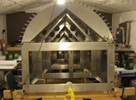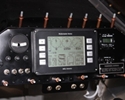


random user submitted photo
In Flight Breakup of N75654 - CAUTION: crash photos
32 posts
• Page 3 of 4 • 1, 2, 3, 4
Re: In Flight Breakup of N75654 - CAUTION: crash photos
Probable cause released today.
http://www.ntsb.gov/aviationquery/brief ... 1705&key=1
Primary cause was fuel exhaustion followed by maneuvers that over stressed the airframe . Contributing factor was the kit manufacturer used a design guideline intended only for conventional tails.
http://www.ntsb.gov/aviationquery/brief ... 1705&key=1
Primary cause was fuel exhaustion followed by maneuvers that over stressed the airframe . Contributing factor was the kit manufacturer used a design guideline intended only for conventional tails.
John Gillis
SEL Private, Comm Glider, Tow pilot (Pawnee Driver)
Waiex N116YX, Jabiru 3300, Tail dragger,
First flight, 3/16/2013. 403 hours and climbing.
Home: CO15. KOSH x 5
Flying a B-Model Conversion (Super Bee Baby!)
-

fastj22 - Posts: 1594
- Joined: Sun Aug 21, 2011 5:56 pm
- Location: Mile High
Re: In Flight Breakup of N75654 - CAUTION: crash photos
*
Last edited by daleandee on Fri Jun 10, 2016 3:04 pm, edited 1 time in total.
-

daleandee - Posts: 877
- Joined: Fri Feb 01, 2013 6:14 pm
Re: In Flight Breakup of N75654 - CAUTION: crash photos
Too bad the GPS track was lost. I'd like to know if the failure was due to overspeed or some high G maneuver. We will never know. I do know that the fix looks like it will not allow this failure to occur again.
John Gillis
SEL Private, Comm Glider, Tow pilot (Pawnee Driver)
Waiex N116YX, Jabiru 3300, Tail dragger,
First flight, 3/16/2013. 403 hours and climbing.
Home: CO15. KOSH x 5
Flying a B-Model Conversion (Super Bee Baby!)
-

fastj22 - Posts: 1594
- Joined: Sun Aug 21, 2011 5:56 pm
- Location: Mile High
In Flight Breakup of N75654 - CAUTION: crash photos
It bothers me that bad build technique, a pilot with known medical issues, and an airplane without fuel were not found to be part of the cause.....
Robbie
Sonex 1517
Sent from my iPad using Tapatalk HD
Robbie
Sonex 1517
Sent from my iPad using Tapatalk HD
Robbie Culver
Sonex 1517
Aero Estates (T25)
First flight 10/10/2015
375+ hours
Jabiru 3300 Gen 4
Prince P Tip
Taildragger
N1517S
Sonex 1517
Aero Estates (T25)
First flight 10/10/2015
375+ hours
Jabiru 3300 Gen 4
Prince P Tip
Taildragger
N1517S
-

Sonex1517 - Posts: 1670
- Joined: Fri Jun 03, 2011 10:11 am
- Location: T25 Aero Estates, Frankston, TX
Re: In Flight Breakup of N75654 - CAUTION: crash photos
To me it seems clear that it was a negative over G maneuver probably with some rudder thrown in:
Had the holes in the bulkhead that the forward angle attached to been better, it may have given enough margin to prevent the accident. With the low experience, and the fact that he ran out of fuel and then apparently did a big pushover, would he have survived if the tail stayed on? I am not sure. I think the motivation for Sonex to re-analyze this area is one positive thing to come out of the accident. There will be a lot more margin for poor workmanship and other factors.
Folks had mentioned the comfort they had in the tank being intact. The loads were probably low because it was empty. If it was full or partly full and survived that crash that would be a lot more telling. Did Sonex drop test the tank? I thought I read that somewhere.
Between the probable cause, the full narrative, the report, and the service bulliten I feel good about the Y tail. This is just my opinion of course. I never worked in accident investigation in my old company though I did work test.
The profile was transversely fractured, separating the horizontal and vertical flanges. Fracture features such as shear lips and rough matte grey surfaces indicated tensile and shear overstress fracturing. There were no indications of fatigue or other progressive crack growth. The profile fracture exhibited a 2.5 to 3 inches long tensile overstress in the vertical flange. The tensile region was at the right edge of the vertical flange, near the profile's fillet. The rest of the profile was fractured by shearing overstress in the horizontal flange.
The horizontal flange of the profile showed out-of-plane deformation, along with clear longitudinal elongations of the bolt holes. The vertical portion of the profile did not show any out-of-plane or within-plane deformation, but the two rightmost bolt holes exhibited elongation in the vertical direction.
Had the holes in the bulkhead that the forward angle attached to been better, it may have given enough margin to prevent the accident. With the low experience, and the fact that he ran out of fuel and then apparently did a big pushover, would he have survived if the tail stayed on? I am not sure. I think the motivation for Sonex to re-analyze this area is one positive thing to come out of the accident. There will be a lot more margin for poor workmanship and other factors.
Folks had mentioned the comfort they had in the tank being intact. The loads were probably low because it was empty. If it was full or partly full and survived that crash that would be a lot more telling. Did Sonex drop test the tank? I thought I read that somewhere.
Between the probable cause, the full narrative, the report, and the service bulliten I feel good about the Y tail. This is just my opinion of course. I never worked in accident investigation in my old company though I did work test.
Bryan Cotton
Poplar Grove, IL C77
Waiex 191 N191YX
Taildragger, Aerovee, acro ailerons
dual sticks with sport trainer controls
Prebuilt spars and machined angle kit
Year 2 flying and approaching 200 hours December 23
Poplar Grove, IL C77
Waiex 191 N191YX
Taildragger, Aerovee, acro ailerons
dual sticks with sport trainer controls
Prebuilt spars and machined angle kit
Year 2 flying and approaching 200 hours December 23
-

Bryan Cotton - Posts: 5496
- Joined: Mon Jul 01, 2013 9:54 pm
- Location: C77
Re: In Flight Breakup of N75654 - CAUTION: crash photos
Sonex1517 wrote:It bothers me that bad build technique, a pilot with known medical issues, and an airplane without fuel were not found to be part of the cause.....
Robbie
Sonex 1517
Sent from my iPad using Tapatalk HD
Fuel exhaustion was found to be the primary cause.
John Gillis
SEL Private, Comm Glider, Tow pilot (Pawnee Driver)
Waiex N116YX, Jabiru 3300, Tail dragger,
First flight, 3/16/2013. 403 hours and climbing.
Home: CO15. KOSH x 5
Flying a B-Model Conversion (Super Bee Baby!)
-

fastj22 - Posts: 1594
- Joined: Sun Aug 21, 2011 5:56 pm
- Location: Mile High
In Flight Breakup of N75654 - CAUTION: crash photos
fastj22 wrote:Sonex1517 wrote:It bothers me that bad build technique, a pilot with known medical issues, and an airplane without fuel were not found to be part of the cause.....
Robbie
Sonex 1517
Sent from my iPad using Tapatalk HD
Fuel exhaustion was found to be the primary cause.
Huh? Quoting the report -
The National Transportation Safety Board determines the probable cause(s) of this accident to be:
The in-flight failure of the aircraft’s Y-tail attachment structure during maneuvering flight due to overload. Contributing to the accident was, the kit manufacturer’s use of 14 CFR Part 23, Appendix A design guidelines intended for a conventional tail airplane without a V- (or Y-) tail.
Did you read something I missed?
Robbie
Sonex 1517
Sent from my iPad using Tapatalk HD
Robbie Culver
Sonex 1517
Aero Estates (T25)
First flight 10/10/2015
375+ hours
Jabiru 3300 Gen 4
Prince P Tip
Taildragger
N1517S
Sonex 1517
Aero Estates (T25)
First flight 10/10/2015
375+ hours
Jabiru 3300 Gen 4
Prince P Tip
Taildragger
N1517S
-

Sonex1517 - Posts: 1670
- Joined: Fri Jun 03, 2011 10:11 am
- Location: T25 Aero Estates, Frankston, TX
Re: In Flight Breakup of N75654 - CAUTION: crash photos
From the prob cause:
Running out of fuel would not be the cause of the tail coming off though. If I ever lose power(again) I don't think I would pull the tail off.
It is likely that the pilot, distracted by the loss of engine power, allowed the airplane to enter an unusual attitude, and the tail separated during the pilot’s attempted recovery from the unusual attitude.
Running out of fuel would not be the cause of the tail coming off though. If I ever lose power(again) I don't think I would pull the tail off.
Bryan Cotton
Poplar Grove, IL C77
Waiex 191 N191YX
Taildragger, Aerovee, acro ailerons
dual sticks with sport trainer controls
Prebuilt spars and machined angle kit
Year 2 flying and approaching 200 hours December 23
Poplar Grove, IL C77
Waiex 191 N191YX
Taildragger, Aerovee, acro ailerons
dual sticks with sport trainer controls
Prebuilt spars and machined angle kit
Year 2 flying and approaching 200 hours December 23
-

Bryan Cotton - Posts: 5496
- Joined: Mon Jul 01, 2013 9:54 pm
- Location: C77
In Flight Breakup of N75654 - CAUTION: crash photos
Thanks! I have no clue how to read thses things yet...
Robbie
Sonex 1517
Sent from my iPad using Tapatalk HD
Robbie
Sonex 1517
Sent from my iPad using Tapatalk HD
Robbie Culver
Sonex 1517
Aero Estates (T25)
First flight 10/10/2015
375+ hours
Jabiru 3300 Gen 4
Prince P Tip
Taildragger
N1517S
Sonex 1517
Aero Estates (T25)
First flight 10/10/2015
375+ hours
Jabiru 3300 Gen 4
Prince P Tip
Taildragger
N1517S
-

Sonex1517 - Posts: 1670
- Joined: Fri Jun 03, 2011 10:11 am
- Location: T25 Aero Estates, Frankston, TX
Re: In Flight Breakup of N75654 - CAUTION: crash photos
fastj22 wrote:Probable cause released today.
http://www.ntsb.gov/aviationquery/brief ... 1705&key=1
Primary cause was fuel exhaustion followed by maneuvers that over stressed the airframe . Contributing factor was the kit manufacturer used a design guideline intended only for conventional tails.
So those "less than optimal building" findings shown in the pictures on the first page had nothing to do with the in flight breakup?
Michael
Sonex #145 from scratch (mostly)
Taildragger, 2.4L VW engine, AeroInjector, Prince 54x48 P-Tip
VH-MND, CofA issued 2nd of November 2015
First flight 7th of November 2015
Phase I Completed, 11th of February 2016
http://www.mykitlog.com/rizzz/
Sonex #145 from scratch (mostly)
Taildragger, 2.4L VW engine, AeroInjector, Prince 54x48 P-Tip
VH-MND, CofA issued 2nd of November 2015
First flight 7th of November 2015
Phase I Completed, 11th of February 2016
http://www.mykitlog.com/rizzz/
- rizzz
- Posts: 869
- Joined: Tue Jun 21, 2011 2:07 am
- Location: Wollongong, NSW, Australia
32 posts
• Page 3 of 4 • 1, 2, 3, 4
Who is online
Users browsing this forum: No registered users and 24 guests







